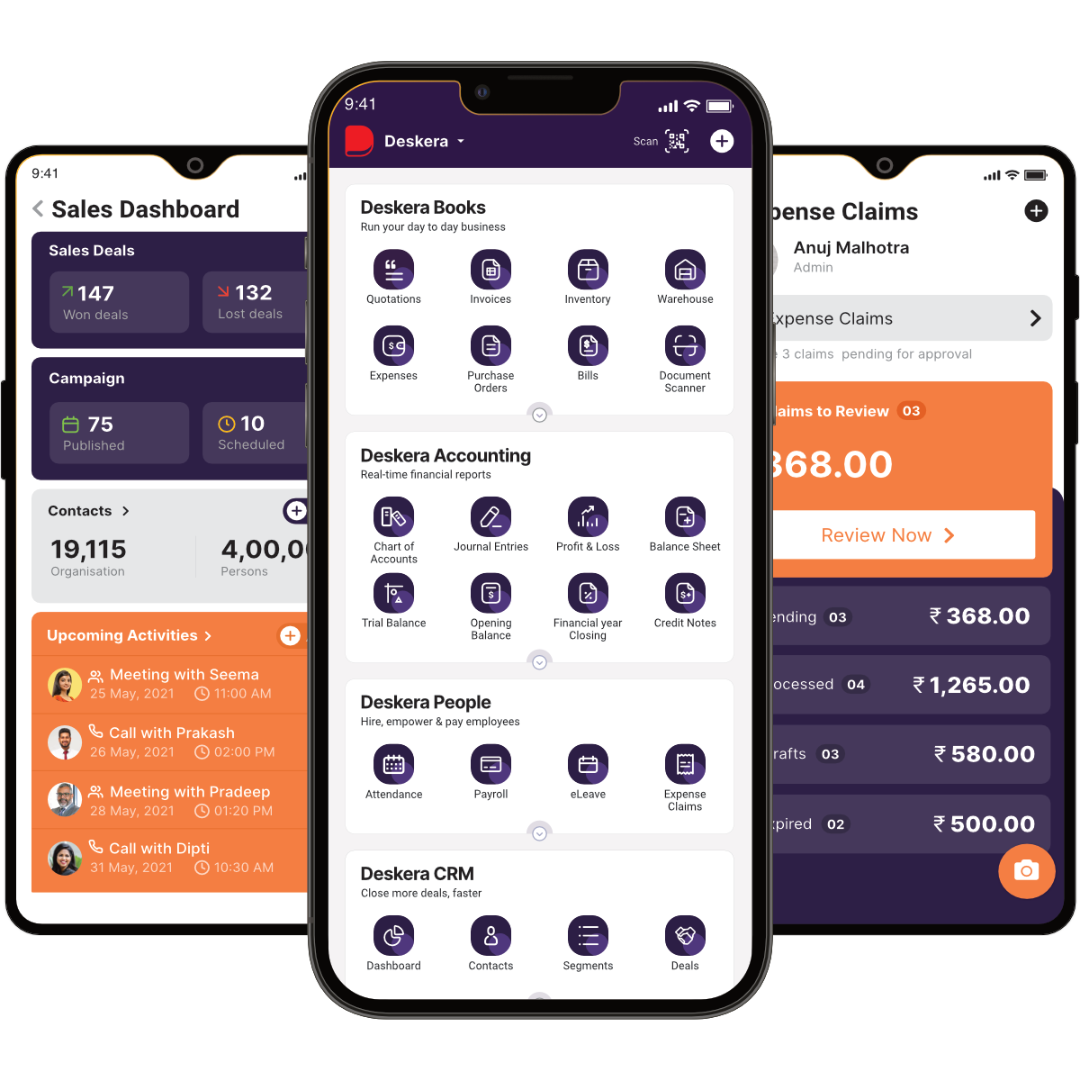Business owners seeking reasonable inventory control must introduce themselves with the inventory jargon. SKUs and UPCs are two such terms. They are used reciprocally, but they are different. Inventory managers and business owners must know where they differ.
In short, SKUs are internally generated numbers for the company to use. On the other hand, UPCs are standardized codes followed universally. They may have similar uses and benefits, but there is much to explore.
This article highlights the differences between the two. Here is all that we shall cover in this article:
- What is UPC?
- What is SKU?
- UPC Vs. SKU
- Uses and Advantages of SKUs
- Uses and Advantages of UPCs
- SKU or UPC: Which one should you Use?
- UPCs Vs. SKUs FAQs
- Conclusion
- How can Deskera Help You?
- Key Takeaways
- Related Articles
What is UPC?
A UPC is an abbreviation for Universal Product Code. It is a 12-digit barcode. It is given to a product for its clear identification. The UPC also helps identify the manufacturer of the product. There are multiple vertical variable-width bars in the barcode. It is primarily used at the point of sale or POS.
IBM developed the first UPC in 1973 to track its merchandise. The UPC has since extended to other countries.
GS1 upholds and regulates the UPC. It is a non-profit organization that operates on a global scale. They also work on supply-and-demand chain standards in a variety of industries.
Understanding UPCs
It is a number that is machine-readable and often known as a barcode. You shall find a UPC on almost every consumer good sold in stores or online. The bars are separated by spaces that are unique to the product. It is a critical component of the order management system.
Depending on the code, there are between 8 and 12 digits beneath the bars. We learn about the manufacturer from the first 6 to 10 digits. We can learn about the item number from the next 1-5 digits. Lastly, we see the last digit, which is the check digit. It ensures that the code is correct.
More about UPC
GS1 assigns a 6-digit manufacturer identification number following payment of a membership fee. These are the first six digits in the UPC on all of the company's products. This number identifies the item's specific manufacturer.
As discussed in the previous section, the next five digits of the UPC are referred to as an item number. It refers to the actual product. Each corporation has a person in charge of issuing item numbers. They ensure that the same number is used only once. They must also ensure obsolete numbers of discontinued products are phased out.
For example, many consumer products come in various sizes, flavors, and colors. Each type must have its own item number. Various calculations lead to this check digit. It requires adding and multiplying several digits in the code. This is done to validate that the UPC is valid to the checkout scanner. The scanning of UPC will only yield results if the check digit code is correct.
UPCs: How do They Work?
UPC barcodes are integral to conventional sales transactions. Barcode readers facilitate scanning merchandise at the checkout. The reader will send the data from the UPC to the POS system. Once the system looks it up, it presents the price attached to the code.
In other words, the price will be shown at the point of sale once the POS system has retrieved the information. This way, the merchants can sell the product at a set price.
The majority of UPC barcodes are designed for high-volume scanning. This is especially noticeable in larger retail establishments. The other sectors, such as the healthcare and medical supplies industry, can benefit from it. They can play a part in identifying medical devices.
Also, they can be advantageous for a business's logistics and warehousing units. And, of course, data tracking is something that comes along with UPCs.
What is SKU?
SKU or Stock Keeping Unit is a unique alphanumeric code provided by a firm to a product. It is used to record the number of pieces sold and in inventory. An SKU is a scannable bar code that is commonly found on product labels in retail stores.
The label enables sellers to track inventory movement automatically. The SKU is an alphanumeric combination of about eight characters. The characters form a code. This code stores the price, product details, manufacturer, and point-of-sale information.
SKUs can also be used to identify intangible products. For example, we can consider units of repair time in an auto body shop. These are billable products. Thus, the company benefits from adding an SKU to it.
SKUs enable managers to detect which products need to be restocked easily. This is possible due to scannable SKUs and a POS system. When a customer purchases an item at the point-of-sale (POS), they scan the SKU. The POS system removes the item from the inventory. It does so while collecting other data, such as the selling price.
SKUs are used to track inventory levels by retailers. They are also used by e-commerce suppliers and service providers. SKUs reliably make warehousing and product fulfillment easier.
Store owners may easily track the number of available products through SKUs. It is possible as each product has a unique SKU. Owners can set threshold restrictions. This alerts them when fresh purchase orders are required.
Model numbers should not be confused with SKUs. But organizations may embed model numbers into SKUs.
SKUs are business specific. Therefore, businesses develop unique SKUs for their products and services. For example, consider a company that manufactures T-shirts. It will include the color, type, and size of the t-shirt on the SKU. This is followed by the manufacturer code.
Here is how the SKU for the T-shirt company will look:
Importance of SKUs
The stock keeping units are crucial to retail stores and warehouses. Also, product fulfillment stations have SKUs as their integral part.
The following list sums up the importance of SKUs:
- SKUs are beneficial in locating a specific product.
- It is useful in inventory tracking. The process helps determine the available quantity of a particular product.
- It assists in the reconciliation of product stock levels.
- It is useful in detecting inventory shrinkage.
- SKUs help in identifying products that have been very profitable.
- They assist in the identification of product reorder points.
- They help clients save time in locating products.
SKUs: How Do They Work?
Letters and numbers make up a stock keeping unit. The numbers and letters provide information about the product, such as the brand, model number, color, and so on. Each company has its own method for producing SKUs for its items. Also, there is no specific way to create an SKU.
Yet, several recommended practices are recommended when creating an SKU for a product.
Let’s catch them here:
- Make each SKU distinct.
- Never reuse an SKU, and ensure that each product has a unique SKU.
- Keep SKUs to a concise length. Long SKUs may need help to read. They may also be incompatible with certain inventory management systems.
- Refrain from using letters that can be confused with numbers. O and I are examples, which can be confused with 0 and 1.
- There should be no spaces or special characters. Making an SKU with gaps or unusual characters may need clarification.
UPC Vs. SKU
Recognizing the distinctions between SKU and UPC is critical for E-commerce sellers. It enables them to optimize their inventory management system better.
Although both are numerical codes allocated to products, SKUs are used internally, while UPCs are used externally. In particular, SKUs are company-specific and used to maintain inventories internally. On the other hand, UPCs are universal tracking codes that allow for accurate product tracking and sales across the supply chain.
The following table gives is a glimpse into the differences between UPC and SKU:
The primary advantage of understanding this difference is that you can have better control over the inventory. Also, you can track your sales across your supply chain efficiently.
Uses and Advantages of SKUs
SKUs assist you in increasing your entire business performance. A well-defined system for distinguishing your products makes it easier to monitor each item. You manage your inventory properly and satisfy your clients' requests.
The advantages of SKUs can be summed up as follows:
- Useful for inventory management: SKUs can be used by E-commerce retailers to track sales and calculate inventory statistics. This component implies that retailers can track their inventory to determine what is in stock.
- Create for free: There are numerous SKU generators accessible online to assist you in creating SKUs for your products.
- Customizable: Merchants can personalize SKUs to express any differentiation between their products and services.
Uses and Advantages of UPCs
With a brief look at the benefits of SKUs, let's focus on the advantages of UPCs. The UPC barcodes are also advantageous because they offer the following:
- Critical to online businesses: Online marketplaces demand UPCs for major brands in the majority of product categories.
- They are included in your purchase: UPCs are assigned by the manufacturers who manufactured the item. Hence, the item will come with a UPC barcode by default. As a result, unlike SKU numbers, you do not need to generate your own UPC.
- Used across the US: UPCs are widely utilized in the United States and are found on all E-commerce platforms and shops. A 13-digit serial number is required for businesses outside of North America and the United States (International Article Number or a European Article Number)
- UPCs are licensed by the item's manufacturer: The universal system used in the United States generates UPCs at random. UPCs remain consistent throughout the supply chain for easy tracking.
While SKU and UPC differ on many accounts, they also have similarities. They both offer the advantages of faster and more accurate product sales and tracking.
SKU or UPC: Which One should you Use?
So, the article focuses on the question: Do I use UPC or SKU? Well, the answer lies in the priorities you have in your business.
When to use UPCs
If you want to grow your business by selling your products to larger and established retailing giants, you will need UPCs. Here, it would be best if you made your items universally compliant by enrolling them with UPC barcodes. Collaboration with large retail outlets like Walmart and Amazon will require you to do so.
UPC-registered products can keep their SKUs for internal reference. This is because tracking your own inventory is still crucial even when combined with a larger shared database.
When to use SKUs
If you are looking to track your inventory internally, then use SKUs. SKUs are an essential tool for managing enterprise inventories. They can be customized to represent the most significant qualities of your products. These include the product’s information like color, brand, type, size, price, and so on.
UPCs Vs. SKUs FAQs
Q: What is the purpose of an SKU code on a product?
A: An SKU code makes tracking products and sales easier. This is beneficial for inventory and supply chain management. With an SKU, it is less probable that you ship the incorrect item to clients, and it also aids with returns if necessary.
Q: Is a barcode the same as an SKU?
A: While SKUs are frequently depicted as barcodes, they are sometimes used in different ways. Barcodes on retail products are known as UPCs. They are designed to recognize products of the same type irrespective of where you sell them.
SKUs, on the other hand, will aid in determining the seller or vendor. Furthermore, UPC barcodes are only digits, whereas SKUs are alphanumeric. Also, SKUs can have different lengths.
Q: How do I obtain an SKU for my product?
A: SKU numbers are frequently found on products alongside the UPC barcode. SKU numbers are not globally standardized. This is because they are meant for the manufacturer to keep track of things. Also, they are business specific and vary accordingly.
Thus, you can create any SKU system for your products that meets your demands. Typically, you will want to design a system with coherent logic. So, you can begin with top-level identifiers and progress to unique product-specific and supplier codes.
Q: Can I use my UPC as an SKU?
A: No, UPCs are not the same as SKUs. The main distinction between SKUs and UPCs is that UPCs are used for external purposes, while SKUs are used for internal purposes.
Q: Is SKU synonymous with GTIN?
A: No, an SKU is not the same as a GTIN. GTINs, or Global Trade Item Numbers, are unique product identifiers that are used globally and do not differ from one business to the other. SKUs, on the other hand, differ from one company to company.
Conclusion
Inventory management requires skills and attention. UPCs and SKUs can be instrumental in the process.
A uniform product code is vital for businesses that want to understand their sales. UPCs are more than just a collection of digits. A UPC barcode is associated with product data. They are convenient and highly regulated. They are meant for referencing products universally.
UPCs are required when you are looking to collaborate with larger online retailers like Amazon and Walmart. You must first apply for a GS1 corporate prefix to receive a valid UPC. Even if the procedure is more complex than it appears, it is worthwhile. UPCs can aid with the simple tracking of merchandise.
Having known UPCs, SKUs are also critical to track inventory. However, they are codes that are internally generated and for internal use.
How can Deskera Help You?
As a manufacturer, you must keep track of your inventory stock. The condition of your inventory has a direct impact on production planning, people and machinery use, and demand estimation.
Deskera ERP and MRP systems can assist you in the following ways:
- Control production schedules
- Compile a Bill of Materials
- Produce thorough reports
- Make your own dashboard.

Deskera ERP is a complete solution that allows you to manage suppliers, track supply chain activity in real time, and streamline a range of other company functions.
Deskera Books allows you to manage your accounts and finances better. It helps maintain good accounting standards by automating billing, invoicing, and payment processing tasks.
Deskera CRM is a powerful tool that organizes your sales and helps you close deals rapidly. It enables you to perform crucial tasks like lead generation via email and gives you a comprehensive view of your sales funnel.
Deskera People is a straightforward application for centralizing your human resource management activities. Not only does the technology expedite payroll processing, but it also helps you to handle all other operations such as overtime, benefits, bonuses, training programs, and much more.
Key Takeaways
- In short, SKUs are internally generated numbers for the company to use. On the other hand, UPCs are standardized codes followed universally.
- A UPC is an abbreviation for Universal Product Code. It is a 12-digit barcode. It is given to a product for its clear identification.
- The UPC also helps identify the manufacturer of the product. There are multiple vertical variable-width bars in the barcode.
- IBM developed the first UPC in 1973 to track its merchandise.
- GS1 assigns a 6-digit manufacturer identification number following payment of a membership fee.
- Barcode readers facilitate scanning merchandise at the checkout. The reader will send the data from the UPC to the POS system. Once the system looks it up, it presents the price attached to the code.
- SKU or Stock Keeping Unit is a unique alphanumeric code provided by a firm to a product. It is used to record the number of pieces sold and in inventory. An SKU is a scannable bar code that is commonly found on product labels in retail stores.
- The characters in SKU form a code. This code stores the price, product details, manufacturer, and point-of-sale information.
- Store owners may easily track the number of available products through SKUs. It is possible as each product has a unique SKU.
- The various benefits of SKUs include tracking a specific product in the inventory, assisting in the reconciliation of product stock levels, being useful in detecting inventory shrinkage, and identifying products that have been very profitable.
- If you want to grow your business by selling your products to larger and established retailing giants, you will need UPCs.
- If you are looking to track your inventory internally, then use SKUs. SKUs are an essential tool for managing enterprise inventories.
Related Articles












